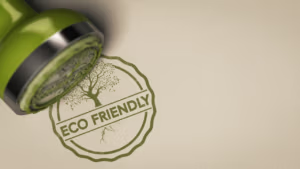Eco-Friendly Pressure Washing: How to Clean Green and Protect the Planet
Pressure washing is a highly effective way to clean surfaces, but it can sometimes have a negative impact on the environment. Using large amounts of water, harsh chemicals, and improper disposal of wastewater can harm local ecosystems. However, eco-friendly pressure washing techniques offer a way to clean effectively while minimizing your environmental footprint. In this guide, we’ll show you how to make your pressure washing routine greener and more sustainable.
1. Use Eco-Friendly Cleaning Solutions
Why It’s Important:
Traditional cleaning solutions often contain chemicals that are harmful to the environment, including phosphates, ammonia, and bleach. When these chemicals enter the water system, they can disrupt aquatic life and contaminate drinking water.
How to Clean Green:
Opt for biodegradable, non-toxic cleaning products specifically labeled as environmentally friendly. Ingredients such as vinegar, baking soda, or plant-based soaps can clean effectively without causing harm to the environment. Look for certifications from organizations like the EPA’s Safer Choice Program to ensure the product meets environmental standards.
To learn more about green cleaning methods, read this blog:
Eco-Friendly Pressure Washing: Green Cleaning Methods for Your Home
2. Limit Water Usage
Why It’s Important:
Excessive water use is wasteful and can contribute to water shortages, especially in areas prone to drought. Minimizing water use during pressure washing is a simple but impactful way to clean more sustainably.
How to Clean Green:
Choose a pressure washer that is water-efficient or equipped with a water-saving nozzle. Adjust the settings to use the lowest pressure necessary for the job. Pre-soak the area with water to loosen dirt, reducing the amount of water needed during the washing process. Consider using a pressure washer with a built-in water recycling feature that filters and reuses water.
To discover more sustainable cleaning practices, read this blog:
Sustainable Pressure Washing Practices for the Eco-Conscious Homeowner
3. Proper Wastewater Management
Why It’s Important:
Wastewater from pressure washing can carry contaminants like oils, dirt, and chemicals into storm drains, which may lead directly to local water bodies, causing pollution.
How to Clean Green:
Use a containment system to capture and properly dispose of wastewater. Direct wastewater away from storm drains and collect it in a designated area for safe disposal. You can also use a vacuum recovery system to suck up wastewater for treatment or disposal at a proper facility.
To learn more about the environmental impact of pressure washing, read this blog:
The Environmental Impact of Pressure Washing: What You Should Know
4. Choose the Right Time and Weather Conditions
Why It’s Important:
The timing of your pressure washing can affect its environmental impact. Washing surfaces when it’s too hot or windy can lead to quick evaporation, requiring more water and increasing the risk of chemical drift.
How to Clean Green:
Schedule your pressure washing on cooler, calm days to minimize evaporation and chemical drift. Avoid washing just before rain, as it can wash away cleaning agents into storm drains or local water bodies. Always check local weather forecasts to plan your cleaning activities accordingly.
5. Use Energy-Efficient Equipment
Why It’s Important:
Energy-efficient pressure washers reduce the amount of electricity or fuel used, which can lower your carbon footprint. Choosing energy-efficient models also reduces costs over time.
How to Clean Green:
Select an energy-efficient pressure washer with a high-efficiency motor or pump. Electric pressure washers are often more environmentally friendly than gas-powered models because they produce fewer emissions. Look for models with the ENERGY STAR label, which indicates high energy efficiency.
6. Consider Soft Washing for Delicate Surfaces
Why It’s Important:
High-pressure washing isn’t always necessary and can sometimes cause damage, requiring further repairs that have an environmental cost. Soft washing uses low-pressure water and eco-friendly detergents, which can be gentler on surfaces and more sustainable.
How to Clean Green:
Use soft washing for cleaning delicate surfaces such as wood, roofing, or siding. Soft washing consumes less water and energy, making it a greener alternative for many residential and commercial cleaning tasks.
To learn more about this method, read this blog:
The Advantages of Soft Washing Over Pressure Washing
7. Regular Maintenance to Prevent Buildup
Why It’s Important:
Preventing the buildup of dirt, mold, and mildew reduces the need for harsh chemicals and frequent pressure washing. Regular cleaning helps maintain surfaces, extending their lifespan and reducing waste over time.
How to Clean Green:
Schedule regular, low-impact cleanings to prevent heavy dirt accumulation. Use eco-friendly cleaning products and methods for ongoing maintenance, which will minimize the frequency and intensity of pressure washing needed.
To learn more about how regular pressure washing benefits your home, read this blog:
The Benefits of Regular Pressure Washing for Your Home
And if you want to further protect your home from harmful growth, read this blog:
How Pressure Washing Helps Prevent Mold and Mildew
How Around The Bend Pressure Washing Can Help You Clean Green
At Around The Bend Pressure Washing, we are committed to providing eco-friendly pressure washing services in Tallahassee, FL, and surrounding areas. Our team uses biodegradable cleaning solutions, water-efficient equipment, and proper wastewater management techniques to minimize our environmental impact. We offer both pressure washing and soft washing services tailored to your needs, ensuring a thorough clean while protecting the planet. Contact us today to learn more about our green cleaning practices and to schedule your eco-friendly pressure washing service!
Brighten your holidays with professional Christmas light installations! You can check our free quote or visit our socials for more info.


3 thoughts on “Eco-Friendly Pressure Washing: 7 Key Points on How to Clean Green and Protect the Planet”
Pingback: Pressure Washing Safety Tips: Protect Yourself and Your Property - Tallahassee Pressure Washing Services
Pingback: Eco-Friendly Pressure Washing: Green Cleaning Methods for Your Home - Tallahassee Pressure Washing Services
Pingback: The Environmental Impact of Pressure Washing: What You Should Know - Tallahassee Pressure Washing Services